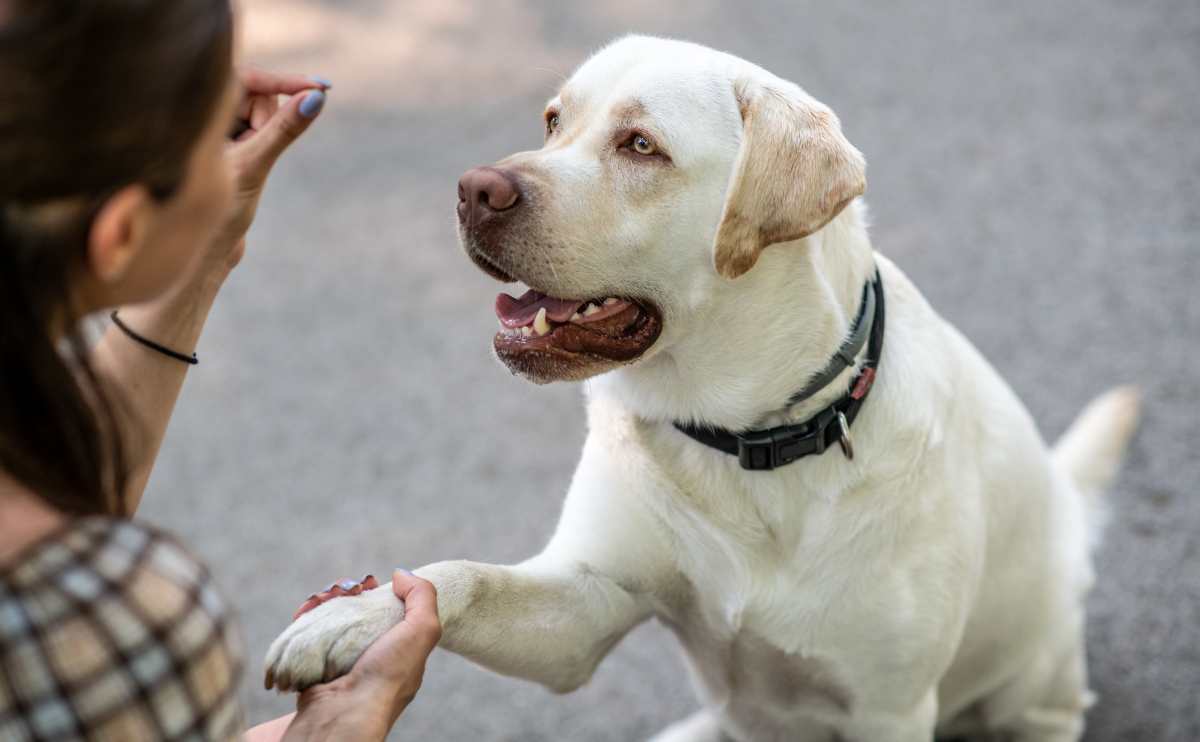When you purchase through links on our site, we may earn a commission. Here’s how it works.
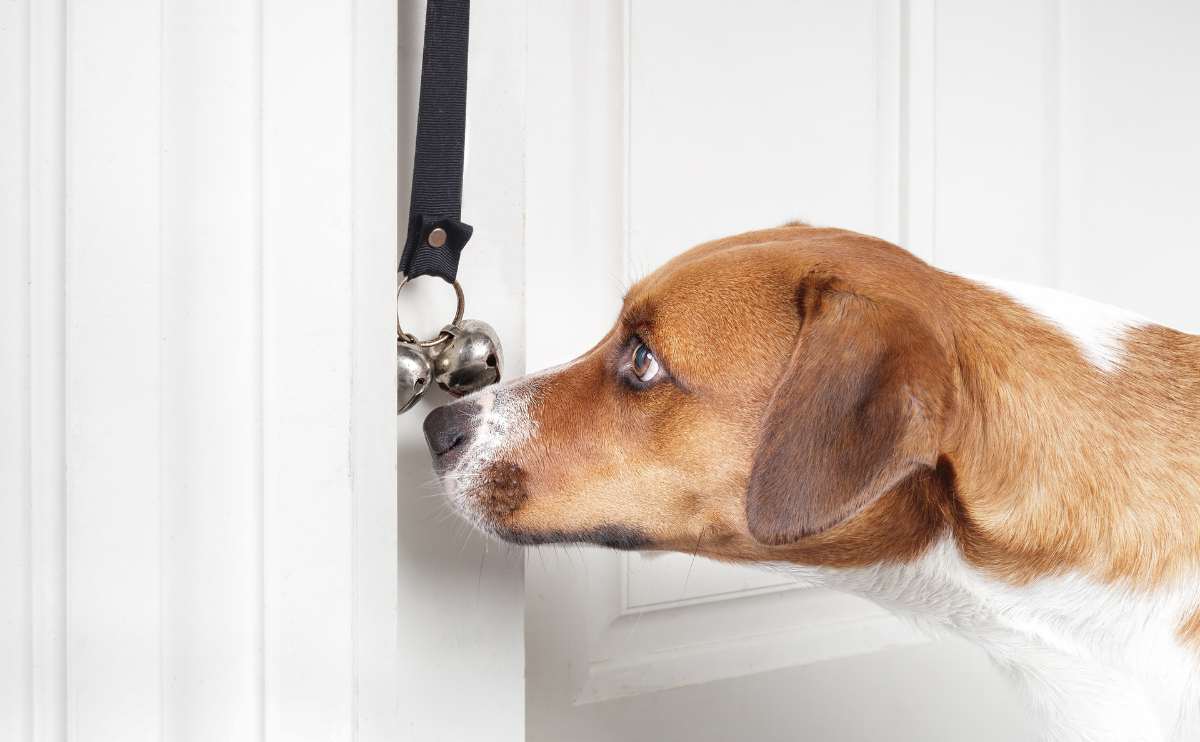
Have you ever considered bell training your dog? It is a method in which you train dogs to use a bell to signal that they need to go outside. While more commonly used in puppies, adult dogs can also be bell trained. Essentially, it’s a means of communication that you can teach your dog to help avoid bathroom accidents inside and prevent those desperate whines and scratching at the door or sullen stares from a pup that needs to go outside. While bell training may not be the first method one thinks of, it can be an incredibly useful tool.
What Is Bell Training For Dogs?
When many people think of bell training, the first thing that comes to mind is the famous researcher Ivan Pavlov. Pavlov used bells and conditioning with dogs in different experiments, pairing the ringing sound with providing them with food. As the experiments progressed, dogs began associating the chimes with food.
They started to salivate when they heard it. Salivation occurred regardless of whether food was offered or not. This conditioning is called the Pavlovian response or the Pavlovian dog effect. The Pavlovian response is also called respondent conditioning or classical conditioning and works as an individual starts to experience an involuntary response to a given stimulus.
When we discuss bell training in dogs, we are not referring to the same kind of experiments that Pavlov conducted. In this case, it refers to teaching a dog to associate the ringing and sound of a chime with needing to go outside. Though not exactly the same, the basic concept is similar.
Why Is Bell Training Useful In Dogs?
While some owners are relatively in tune with their dog’s bathroom needs, for many, this is a significant challenge. It can result in dogs not being let out enough or owners spending excess time outside pressuring their pets to use the restroom. Feeling like potty time is unproductive can create a stressful situation for both you and your pup.
Many different scenarios in which using bells to condition a puppy or adult pooch can be especially useful. When first housebreaking a puppy, this method can help set lifelong behavior standards. It can also help set up a better functioning bathroom routine and alleviate excess trips outside when dogs do not need to go to the bathroom.
7 Benefits Of Bell Training
- Puppies have difficulty alerting you that they must go outside. Some puppies and small breeds like Chihuahuas sneak off and pee in the house rather than going outside.
- It helps prevent accidents and odorous messes inside the home.
- It is helpful with aging pets who may be experiencing frequent urges to urinate or are experiencing other gastrointestinal difficulties when in a new home or environment.
- It is helpful for owners who are unable to determine when their dogs need to get outside accurately or how long they can hold their pee.
- If you live in small spaces or apartments, training a pup to ring the chimes to get outside rather than barking is helpful to keep noise levels down.
- It may reduce excessive time spent outside without satisfactory potty results.
- It is helpful to alleviate stress from going outside to use the restroom.
How To Bell Train A Dog & Potty Train A Dog With A Bell
Bell training your pet is not as intimidating as it may seem. You don’t need to be a scientific researcher like Pavlov to be able to accomplish this task with your pet. The first thing to remember is that this is a learning process for your puppy or adult pooch and you.
What You’ll Need To Start
- Training doorbells
- Treats, toys, or other rewards
- Time
- Appropriate physical setup with doorbells installed properly for dog’s use
- Training videos
- A well-laid-out plan
Steps For Bell Training A Dog

Setting up your equipment first is a crucial step, whether you are coaching an adult or a puppy. You need to hang or install a bell within reach of your dog on the door that pets use most often to go out for a potty break. If they use more than one door, set up multiple doorbells. For example, if your pet often goes out the back door but sometimes hangs out and goes out through the garage door, put a bell on each door.
You’ll need to use the bell every single time you take your puppy out. Do not skip this. It is essential as you train pups to associate the bell sound with going outside. The association starts well before teaching them to ring it themselves.
After a few days of ringing when you take your pup outside, teach her to do it herself. Most pups can ring the chimes with their nose, paws, or both. It may be helpful to use a nose or paw target, which will make it even easier for dogs to understand it’s their turn to ring.
Once your pup has learned to use the bells, train or ask her to do so on command using a word, hand signal, or pointer. Once a pup rings, give her plenty of praise and rewards like treats. When they go out and go to the bathroom, they get another reward.
Eventually, your dog will associate the ringing sound and action with going outside. Treats may prompt them to ring it when they do not have to use the bathroom because they will associate it with those treats.
With time, reduce the reward. The ringing will simply become routine behavior.
Keep in mind that practice is imperative, so it’s important to use the tools every single time they go outside after you start to train. If you are leaving your pets with someone else, they must continue with these efforts.
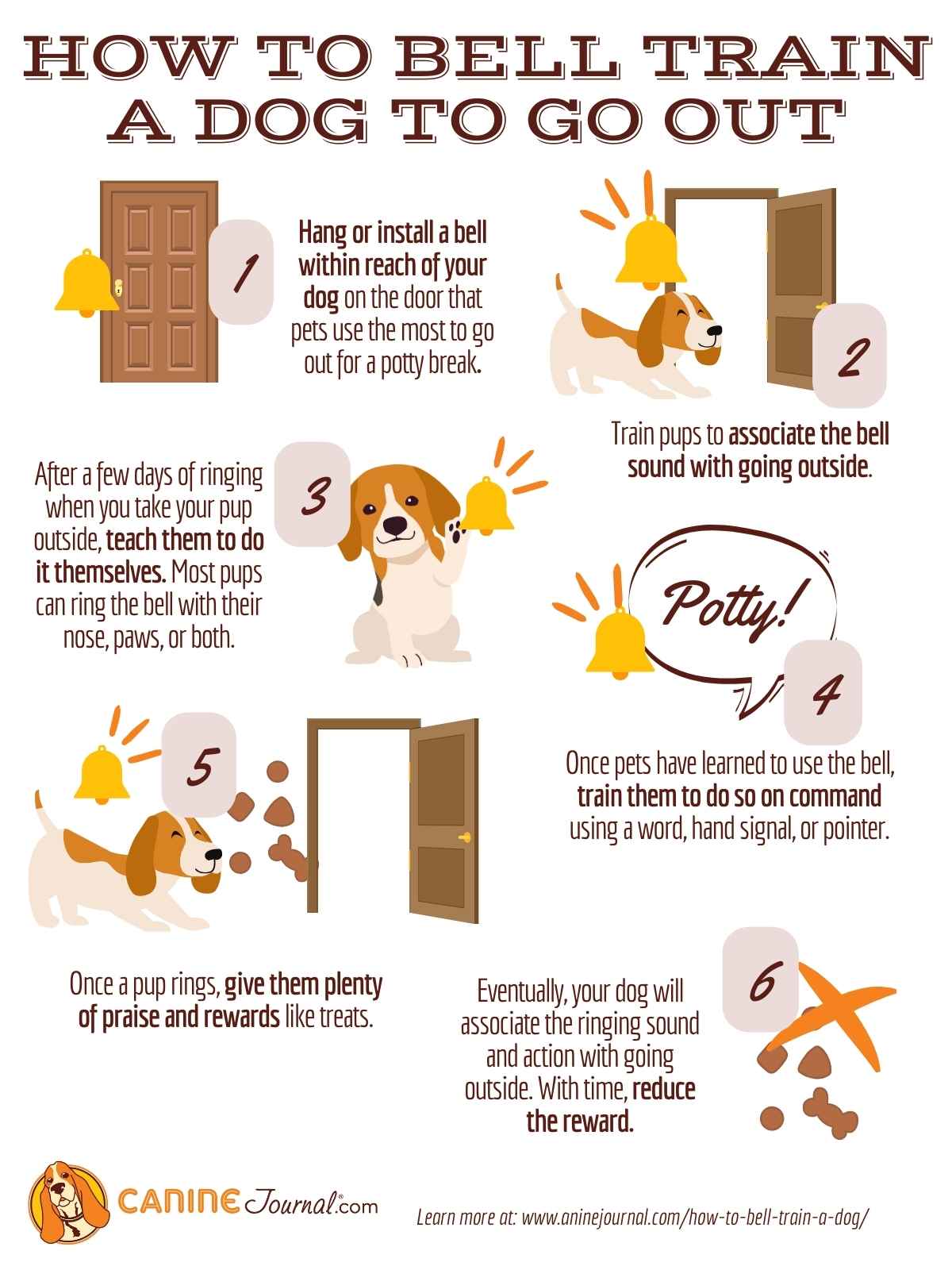
Bell Training A Puppy
For puppies, housebreaking is very reward-based, whether using bells or not. Using them adds an extra layer. Puppies need a reward when they go outside and use the restroom. Adding the chimes means they need a second reward for going out, but it does not necessarily have to be a treat.
Bell Training Adult Dogs
Changing behavior in adult dogs can be more complicated than with the puppy, but this is only true in some cases. Contrary to popular belief, older pups can be taught new tricks and new behaviors with the right approach.
When conditioning an adult dog with a bell, it may be best to teach them to ring it first without associating it with going outside. Once they have learned how to ring, they can connect the dots. You should set your pups up to go out, complete with harnesses, collars, and leashes. Lead them to the door and have them ring the bell. Once it rings, go out and promptly offer a treat. Take them back inside and repeat this behavior until your pup rings unprompted to go outside.
For older pets who already know they need to go outdoors, associating the chime with a positive experience outdoors is helpful, as they are already potty trained.
Mistakes To Avoid
Many people who try this method with a puppy or adult pooch give up if they feel the approach is not working. However, on many occasions, it’s ineffective due to mistakes in the presentation or approach an owner is making.
- One thing to keep in mind is to keep things simple. Sometimes, this means not teaching dogs both ringing and outdoor association simultaneously.
- Some trainers and pet parents prefer to train a dog how to jingle the chimes first physically and then associate it with going out. Others will associate the chime sound with going outside at the same time.
- For pups who do not seem to take to it quickly, teaching them to use the chimes first by dangling it in front of them a few feet away and then rewarding them with a treat can teach a positive association for ringing the bells. From there, it gets rung before going out.
- Don’t move your dog’s paw, head, or other body parts to make your pup shake the bell. Doing so is not helpful and does not train a pup to associate the ringing with the behavior. You’re doing something that causes the chimes to sound, not helping pets learn how to ring them.
- In some cases, dogs may become obsessed with ringing the bell. In this case, bell training may not work. You might consider automatic dog doors controlled by a collar key or app. Consider the Pet Safe Never Rust Electronic pet door if you prefer this option.
Personal Experience With Bell Training Dogs
Many dog owners have had success with bell training. One such owner shared their experience with us.
I bell-trained my dog Charlie, a Jack Russell Terrier, to ring a bell to go outside when he had to pee. Once he learned it, Charlie was great at it and continued to use the bell for the rest of his life. It worked well for us and prevented indoor accidents.
-Michelle B., Jack Russell Terrier Parent
Best Dog Bell For Potty Training
There are a variety of different products available to assist pet parents. Many are quite simple, while others may include other elements. We have taken a look at a few of the options out there and share our reviews below. These come in both traditional forms as well as electronic varieties.
Best Basic Dog Doorbell: BLUETREE Adjustable Bells Review
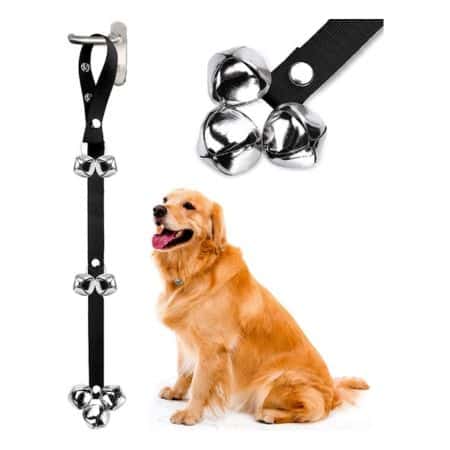
For people just starting out with their pup, the BLUETREE affordable two-pack is an excellent place to start. It can be used in just three simple steps. These adjust to three different levels of length so you can place the jingle near the bottom of the door or a little higher, depending on your dog’s size.
These are made of durable metal and coated in silver, so they are shiny and easy to see. They are 1/4 inch thick and chrome-coated and designed to be extra loud. Each strap comes with seven jingles. These are very popular picks and are highly rated by customers. Simple yet highly effective, they are a great pick for both puppies and adults.
Price
- Starting at $6.99
Personal Experience With BLUETREE Dog Training Bells
I currently have this set of doggy doorbells by BLUETREE. They are made well and easily attached to my door handle. I have a very small pup, a Poodle Beagle mix, so I used a suction cup to get them closer to his eye level. Once installed, they are effortless to use. I am trying this method due to my pup, Falkor, being stubborn about going out to potty. He refuses to go out when our other dog does but then whines and begs to go out just a brief time later.
We hope the training will help eliminate some of this behavior by letting him communicate more clearly that he wants to go out. We are working on ringing. He can reach them with his nose and gets excited when we ring the bells to go outside. Hopefully, we will move into using the bell to go outside soon. My larger dog, Daisy, picked up on ringing the bells with her nose right away and has rung it a few times to go out on her own. She seems to like that she can get our attention whenever she hits that bell.
Best Electronic Dog Doorbell: Mighty Paw Smart Doorbell Review
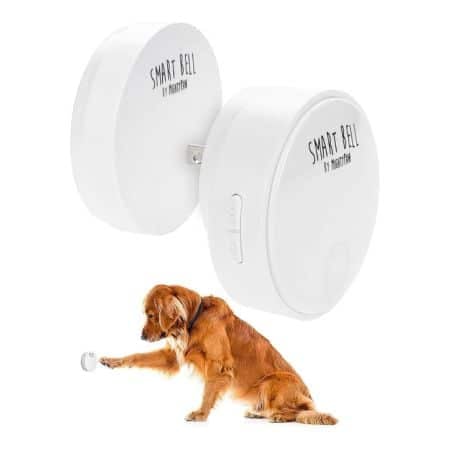
For pet parents who do not want a traditional metal jingle, there are other options, including this electronic doggy doorbell by Mighty Paw. The smart doorbell is wireless and does not need any batteries. It is easy to use and can be installed in just a few moments with no fuss. It can work for all pups, and the activator can withstand pressure from larger breeds.
There are three volume settings and an LED light indicator. The Mighty Paw doggy doorbell is designed to reduce whining, door scratching, and barking and is intended for use with any pup, adult, or puppy. The product can be used indoors or outdoors, so you can train your dogs to ring it to go out but also to ring it when they want to come back inside. It’s available in one or two applicator packs. This is an easy-press button design that any pup can easily push in with their paw or nose.
Price
- Starting at $29.99 (1 pack)
Best Desk Style Dog Bells For Potty Training: Comsmart Pet Potty Training Doorbells Review
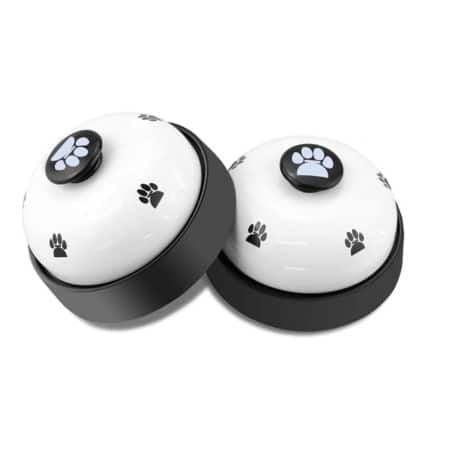
The Comsmart two-pack of doggy doorbells is helpful for pups of all sizes and can even be used with cats. These are desk-style rather than jingles. They can sit flat on the floor or furniture and feature a non-skid design to prevent scratching and movement. Installation is as simple as placing them on any flat surface. Pets ring these by tapping the flat button on the top, which can be done with either their nose or paw.
These are made of sturdy metal material and painted white with charming, printed paw print accents. This paint adds to the aesthetic but also prevents them from rusting. Comsmart’s desk doorbells are light and easy to carry, so they are easily portable when on the go.
Price
- Starting at $7.99 ($4.00 / Count)
What About Training Treats?
Anytime you’re getting ready to train your pup for new behavior, tricks, bell train, potty train, or other behavior conditioning, it is essential to have plenty of treats on hand. Many training treats include tasty freeze-dried nibbles, low-calorie treats, CBD treats, vegan treats, homemade treats, and other tasty rewards.
As an alternative to treats, you can also use games, toys, and verbal praise as a reward. Be careful not to offer too many treats. Remember, treats of any kind should only make up 10% of a pup’s daily calorie intake. If you are interested in training your dog without treats, we cover that, too.
Wondering About Other Training?
Bell conditioning can be a valuable tool for both puppies and adults. However, there are many other types of training you may want to consider with your pup. These include clicker training, proper leash behavior, teaching your pup not to bark excessively, general socialization, stopping bad behavior, and more. For persistent or destructive behavior, it’s crucial to seek out the advice of a certified and experienced animal trainer. If you cannot go to in-person classes, there are plenty of online options that also offer one-on-one sessions.
Why Trust Canine Journal?
Danielle is a pet owner with over 30 years of experience. She has worked as a professional researcher for many years, as well as has experience as a professional educator. She is dedicated to providing the best data-backed research and information to help pet owners. Danielle spends countless hours researching the latest pet care, health, nutrition, and training developments. She works alongside a professional and experienced team to bring the best, most accurate, and up-to-date information to our readers.
Tagged With:
